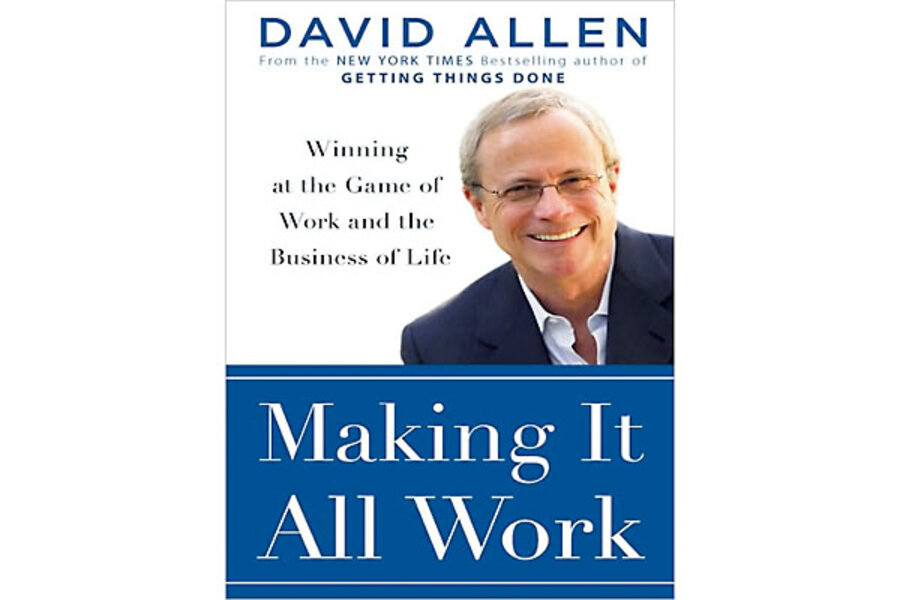Making It All Work – Getting Control: Applying This to Life and Work
Loading...
Allen takes an interesting detour in this chapter. Here, Allen uses the example of Ron Taylor and a business that fell into his lap, Gracie’s Gardens, as an example of the ideas presented in the previous several chapters.
It’s a pretty straightforward story, something that could happen to many of us. Ron’s great aunt passes away and leaves him her small gardening business, the aforementioned Gracie’s Garden. Unfortunately, she hasn’t done a thing with the business in several months, so the greenhouse is like a jungle, the bills are unpaid, there’s a mountain of mail sitting there, and so on.
What does Ron do? Basically, he follows the steps of the previous chapters in moving from staring at the disaster to taking charge of the business.
Capture
On page 194, Allen spells out the first step in Ron’s journey:
The very first thing Ron does is to take a quick site walkthrough, just to identify the property lines and to notice what the obvious things are within them. Next, he clears off the top of the old oak desk in the small office, sets up an in-basket, gets a legal pad and a pen, and does another site walkthrough, this time making notes about anything that grabs his attention and gathering any paper-based or physical items that look as if they might have meaning.
In other words, the first step is to simply gather all relevant information and things that need to be done together in one place.
This is a far superior approach than just diving in to one specific task, like clearing out the greenhouse. For one, it allows Ron to sit back and make realistic decisions about all the tasks (clarifying, the next step). For another, it allows Ron to get a grasp on how big the overall task in front of him really is.
Clarify
Ron then goes on to give some clarity to the big pile of stuff in front of him. On page 195:
Now Ron has to start making some “businesslike” decisions. What assets are worth keeping? What of the viable inventory is worth keeping? What files need to be saved? What supplies are still useful?
Each of those questions involve making decisions and breaking down that specific thought into manageable and clear tasks that don’t have a person asking more questions when they see the item on their to-do list.
Take the greenhouse, for example. Is there anything in there worth saving? If not, it needs to just be cleared out. Is that a good use of Ron’s time, or should he just hire a high schooler to clear it all out for some pocket money? If he chooses to hire a high schooler, there’s the start of a project that has multiple steps. Call a few potential people that might be willing to do it. Negotiate a wage and a time with them. Be on hand to explain the job when they’re about to do it.
Organize / Reflect / Engage
The other steps follow clearly from the clarification. Organize the material on hand into a filing system, into project plans, and into other useful structures of information. Reflect regularly upon all of this that you’ve done. Then, actually take on that to-do list that should consist of specific items that you don’t have to think about, just execute.
It all flows together. In my experience, it all flows together quite well.
The Greater Context of Life
The most interesting part of the chapter, though, is the concluding bit, where Allen writes about how these processes connect back to the greater scope of Ron’s life. Obviously, Gracie’s Gardens isn’t going to be the sole focus of Ron’s life right now, just one piece of it (and perhaps a temporary piece).
On page 196, Allen lays it out:
The unexpected inheritance of a small business you know nothing about is a good example of the kinds of input most of us receive from time to time – a novel event that could be either good or bad, or both. But no matter what the ultimate evaluation of how positive or negative this experience might be, it’s certainly new, different, and demanding of our attention in the moment. And, since Ron already has far more to do than he can keep up with in the rest of his life, one more demanding project can certainly jangle his system to the point of knocking him off balance.
So now that Ron has been able to stabilize Gracie’s Gardens to some degree, he knows he needs to do the same thing for himself, given the unexpected complication this has brought to his world.
In other words, Ron will basically apply the capture/clarify/organize/reflect/engage process over every context of his life, not just that of the business he’s inherited.
What’s the point of mentioning this? These processes work very well in every context of your life, from planning household chores and your Christmas list to convincing you to start a microbusiness and keeping your professional obligations straight.
I’ve been using them for years in a borderless fashion between my personal and professional efforts. The only difference between them is the context, really.
Add/view comments on this post.
------------------------------
The Christian Science Monitor has assembled a diverse group of the best economy-related bloggers out there. Our guest bloggers are not employed or directed by the Monitor and the views expressed are the bloggers' own, as is responsibility for the content of their blogs. To contact us about a blogger, click here. To add or view a comment on a guest blog, please go to the blogger's own site by clicking on the link above.





